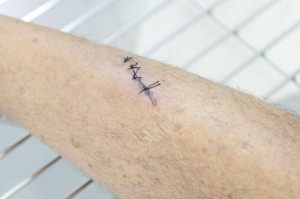How To Know When You Need Stitches
 Do you need stitches? Your skin is your body’s first layer of defense but in people of all ages this defensive guard is commonly cut open. Playing on your bike, preparing dinner, or tripping over a shoe can all lead to a cut that may or may not require stitches. The most important thing is to keep the cut clean of infection. Your skin has the miraculous power to heal itself, but an infection can lead to more serious issues. Stitches may or may not help keep a wound free of infection while it heals.
Do you need stitches? Your skin is your body’s first layer of defense but in people of all ages this defensive guard is commonly cut open. Playing on your bike, preparing dinner, or tripping over a shoe can all lead to a cut that may or may not require stitches. The most important thing is to keep the cut clean of infection. Your skin has the miraculous power to heal itself, but an infection can lead to more serious issues. Stitches may or may not help keep a wound free of infection while it heals.
Generally, if your skin requires stitches it should be stapled or stitched within 6-8 hours post-injury. Although, some wounds can be closed as long as 24-hours post-injury. The more time a wound remains open the greater your chance for infection, and infection is the number one thing you want to prevent with any cut. In this blog we explain how to determine if your wound requires stitches.
What To Do With Deep Skin Wounds
As soon as you experience a very deep cut you want to thoroughly wash out the wound until it stops bleeding. Once cleaned up, a good way to tell if you may or may not need stitches is to physically pinch the two sides of the wound together. If this causes the wound to look better, stitches may be necessary. If you suspect you need stitches do not apply any antiseptic or antibiotic ointment to the wound until after a doctor has examined your injury.
Where Is Your Injury Located? Injury Location Impacts Need For Stitches
Treatment methods vary depending on where your injury is located. For instance, wounds with an increased risk for infection are typically stitched within 6 hours of receiving the injury. Injuries with a heightened risk for infection include crush injuries and dirty cuts.
In some cases, a cut that has an extremely high risk for infection may not be stitched until 24-hours later, or not at all in order to continually clean out and treat the wound. If you are cut with a clean object and there is little to no risk of infection, injuries are generally stitched within 12 to 25 hours.
If the cut is on your face, medical treatment should be conducted as soon as possible in order to help reduce the chance for scarring.
Cuts to the scalp often require stitching because there are many blood vessels that run through this part of your body, and sewing up scalp wounds can help stop the bleeding.
If your cut is located in an area that moves a lot, such as your knee, stitches are beneficial to keep the cut from constantly being pulled back apart.
When Does A Cut Require Urgent Medical Attention?
Cuts come in a variety of depths, some far more serious than others. Sometimes it can be hard to determine if you need to visit a doctor for stitches. Before racing you or your loved one off to your local Urgent Care Center it’s important that you know what to look for. The following signs indicate your injury requires attention from a doctor:
- If your wound appears to be more than 0.24 inches deep, and longer than 0.75 inches. The wound may include a gape opening or jagged edges.
- If you can see fat, muscle, bone, or deep tissue structures located beneath the epidermis.
- If the wound is located near a joint and opens further to reveal deeper tissues when you move that joint.
- Most deep wounds located on the hands and fingers require stitches.
- Wounds that present cosmetic concerns such as a risk for scarring on your lips and face.
- Wounds to the eyelids most often require treatment for both cosmetic and functional purposes.
- If your wound does not stop bleeding after applying direct pressure for 15 minutes or more.
- If there are any foreign objects trapped inside of the cut.
- If you experience a loss of sensation around the wound.
Not all wounds require stitches, but if you are experiencing any of the above it’s important to visit with a doctor to make sure you don’t need stitches.
When Do You Not Need Stitches?
While some cuts require stitching, other cuts can heal on their own without stitching. Wounds that are smaller do not require stitches simply because they will heal better without them. Signs that your wound may not require stitches include:
- Smaller wounds that are less than 0.25 inches deep and smaller than 0.75 inches in length.
- Wounds that have smooth edges and the edges do not gap apart during normal movement.
- Most puncture wounds do not require stitches and if sealed up may present a greater risk for infection because the wound is not able to properly drain and heal.
Are you still unsure if you need stitches or not? Clean and bandage the wound and watch it closely. If you remain concerned, visit your local Urgent Medical Center.

